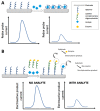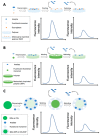Affinity Sensing Strategies for the Detection of Pesticides in Food
- PMID: 30189666
- PMCID: PMC6165126
- DOI: 10.3390/foods7090148
Affinity Sensing Strategies for the Detection of Pesticides in Food
Abstract
This is a review of recent affinity-based approaches that detect pesticides in food. The importance of the quantification and monitoring of pesticides is firstly discussed, followed by a description of the different approaches reported in the literature. The different sensing approaches are reported according to the different recognition element used: antibodies, aptamers, or molecularly imprinted polymers. Schemes of detection and the main features of the assays are reported and commented upon. The large number of affinity sensors recently developed and tested on real samples demonstrate that this approach is ready to be validated to monitor the amount of pesticides used in food commodities.
Keywords: affinity sensors; aptamers; electrochemical detection; immunosensors; molecularly imprinted polymers; optical detection; pesticides.
Conflict of interest statement
The authors declare no conflict of interest.
Figures








Similar articles
-
Progress on Electrochemical Biomimetic Nanosensors for the Detection and Monitoring of Mycotoxins and Pesticides.Toxins (Basel). 2024 May 26;16(6):244. doi: 10.3390/toxins16060244. Toxins (Basel). 2024. PMID: 38922139 Free PMC article. Review.
-
Biosensor technology for pesticides--a review.Appl Biochem Biotechnol. 2015 Mar;175(6):3093-119. doi: 10.1007/s12010-015-1489-2. Epub 2015 Jan 18. Appl Biochem Biotechnol. 2015. PMID: 25595494 Review.
-
Recent developments in non-enzymatic (bio)sensors for detection of pesticide residues: Focusing on antibody, aptamer and molecularly imprinted polymer.Talanta. 2021 Sep 1;232:122397. doi: 10.1016/j.talanta.2021.122397. Epub 2021 Apr 22. Talanta. 2021. PMID: 34074393 Review.
-
Recent advances in synthesis and modification of carbon dots for optical sensing of pesticides.J Hazard Mater. 2022 Jan 15;422:126881. doi: 10.1016/j.jhazmat.2021.126881. Epub 2021 Aug 10. J Hazard Mater. 2022. PMID: 34449329 Review.
-
Electrochemical molecularly imprinted polymer based sensors for pharmaceutical and biomedical applications (review).J Pharm Biomed Anal. 2022 Jun 5;215:114739. doi: 10.1016/j.jpba.2022.114739. Epub 2022 Mar 25. J Pharm Biomed Anal. 2022. PMID: 35429723 Review.
Cited by
-
Glyphosate Separating and Sensing for Precision Agriculture and Environmental Protection in the Era of Smart Materials.Environ Sci Technol. 2023 Jul 11;57(27):9898-9924. doi: 10.1021/acs.est.3c01269. Epub 2023 Jun 29. Environ Sci Technol. 2023. PMID: 37384557 Free PMC article. Review.
-
Rapid Multi-Residue Detection Methods for Pesticides and Veterinary Drugs.Molecules. 2020 Aug 7;25(16):3590. doi: 10.3390/molecules25163590. Molecules. 2020. PMID: 32784605 Free PMC article. Review.
-
Facile and Low-Cost SPE Modification Towards Ultra-Sensitive Organophosphorus and Carbamate Pesticide Detection in Olive Oil.Molecules. 2020 Oct 28;25(21):4988. doi: 10.3390/molecules25214988. Molecules. 2020. PMID: 33126549 Free PMC article.
-
Trends and Perspectives in Immunosensors for Determination of Currently-Used Pesticides: The Case of Glyphosate, Organophosphates, and Neonicotinoids.Biosensors (Basel). 2019 Feb 4;9(1):20. doi: 10.3390/bios9010020. Biosensors (Basel). 2019. PMID: 30720729 Free PMC article. Review.
-
Total phenolics, flavonoids, and antioxidant activity of agricultural wastes, and their ability to remove some pesticide residues.Toxicol Rep. 2022 Mar 29;9:628-635. doi: 10.1016/j.toxrep.2022.03.038. eCollection 2022. Toxicol Rep. 2022. PMID: 35399213 Free PMC article.
References
-
- World Health Organization . Manual on Development and Use of FAO and WHO Specifications for Pesticides. World Health Organization; Geneva, Switzerland: 2016. Third Revision.
-
- Garcia F.P., Ascencio S.Y.C., Oyarzun J.C.G., Hernandez A.C., Alavarado P.V. Pesticides: Classification, uses and toxicity. Measures of exposure and genotoxic risks. J. Res. Environ. Sci. Toxicol. 2012;1:279–293.
-
- Díaz-González M., Gutiérrez-Capitán M., Niu P., Baldi A., Jiménez-Jorquera C., Fernández-Sánchez C. Electrochemical devices for the detection of priority pollutants listed in the eu water framework directive. TrAC Trends Anal. Chem. 2016;77:186–202. doi: 10.1016/j.trac.2015.11.023. - DOI
-
- Wong A., Silva T.A., Caetano F.R., Bergamini M.F., Marcolino-Junior L.H., Fatibello-Filho O., Janegtiz B.C. An overview of pesticide monitoring at environmental samples using carbon nanotubes-based electrochemical sensors. C. 2017;3:8. doi: 10.3390/c3010008. - DOI
-
- Kumar J., Melo J.S. Overview on biosensors for detection of organophosphate pesticides. Curr. Trends Biomed. Eng. Biosci. 2017;5:555–663.
Publication types
LinkOut - more resources
Full Text Sources
Other Literature Sources

